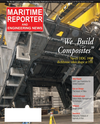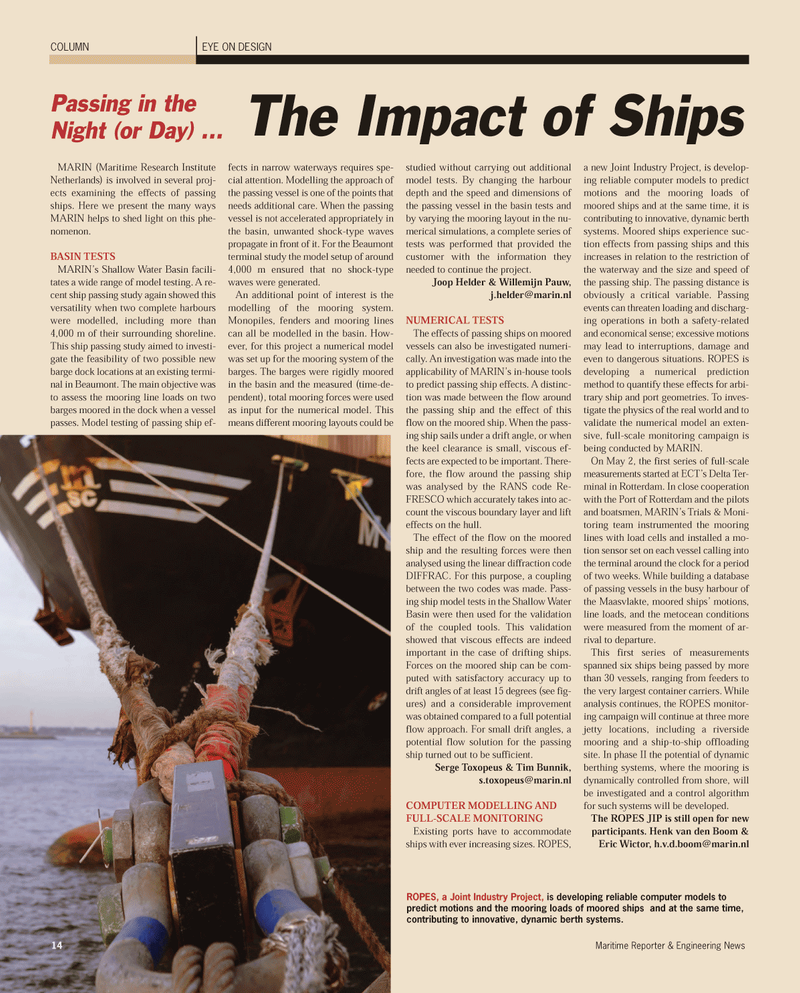
Page 14: of Maritime Reporter Magazine (January 2012)
US Navy Report
Read this page in Pdf, Flash or Html5 edition of January 2012 Maritime Reporter Magazine
MARIN (Maritime Research InstituteNetherlands) is involved in several proj- ects examining the effects of passing ships. Here we present the many ways MARIN helps to shed light on this phe-nomenon. BASIN TESTS MARIN?s Shallow Water Basin facili- tates a wide range of model testing. A re-cent ship passing study again showed this versatility when two complete harbours were modelled, including more than4,000 m of their surrounding shoreline.This ship passing study aimed to investi- gate the feasibility of two possible new barge dock locations at an existing termi- nal in Beaumont. The main objective was to assess the mooring line loads on two barges moored in the dock when a vessel passes. Model testing of passing ship ef-fects in narrow waterways requires spe- cial attention. Modelling the approach ofthe passing vessel is one of the points that needs additional care. When the passing vessel is not accelerated appropriately in the basin, unwanted shock-type waves propagate in front of it. For the Beaumont terminal study the model setup of around4,000 m ensured that no shock-typewaves were generated. An additional point of interest is themodelling of the mooring system.Monopiles, fenders and mooring linescan all be modelled in the basin. How- ever, for this project a numerical model was set up for the mooring system of the barges. The barges were rigidly moored in the basin and the measured (time-de-pendent), total mooring forces were usedas input for the numerical model. This means different mooring layouts could be studied without carrying out additionalmodel tests. By changing the harbourdepth and the speed and dimensions ofthe passing vessel in the basin tests and by varying the mooring layout in the nu- merical simulations, a complete series oftests was performed that provided the customer with the information they needed to continue the project. Joop Helder & Willemijn Pauw, [email protected] TESTS The effects of passing ships on moored vessels can also be investigated numeri- cally. An investigation was made into the applicability of MARIN?s in-house tools to predict passing ship effects. A distinc- tion was made between the flow around the passing ship and the effect of this flow on the moored ship. When the pass- ing ship sails under a drift angle, or whenthe keel clearance is small, viscous ef- fects are expected to be important. There- fore, the flow around the passing ship was analysed by the RANS code Re- FRESCO which accurately takes into ac- count the viscous boundary layer and lifteffects on the hull. The effect of the flow on the moored ship and the resulting forces were thenanalysed using the linear diffraction code DIFFRAC. For this purpose, a coupling between the two codes was made. Pass- ing ship model tests in the Shallow Water Basin were then used for the validation of the coupled tools. This validation showed that viscous effects are indeed important in the case of drifting ships.Forces on the moored ship can be com- puted with satisfactory accuracy up to drift angles of at least 15 degrees (see fig- ures) and a considerable improvement was obtained compared to a full potential flow approach. For small drift angles, a potential flow solution for the passing ship turned out to be sufficient. Serge Toxopeus & Tim Bunnik, [email protected] MODELLING AND FULL-SCALE MONITORING Existing ports have to accommodate ships with ever increasing sizes. ROPES, a new Joint Industry Project, is develop- ing reliable computer models to predictmotions and the mooring loads ofmoored ships and at the same time, it iscontributing to innovative, dynamic berth systems. Moored ships experience suc- tion effects from passing ships and this increases in relation to the restriction ofthe waterway and the size and speed of the passing ship. The passing distance is obviously a critical variable. Passing events can threaten loading and discharg- ing operations in both a safety-relatedand economical sense; excessive motions may lead to interruptions, damage andeven to dangerous situations. ROPES is developing a numerical prediction method to quantify these effects for arbi- trary ship and port geometries. To inves- tigate the physics of the real world and to validate the numerical model an exten- sive, full-scale monitoring campaign is being conducted by MARIN. On May 2, the first series of full-scale measurements started at ECT?s Delta Ter- minal in Rotterdam. In close cooperationwith the Port of Rotterdam and the pilotsand boatsmen, MARIN?s Trials & Moni- toring team instrumented the mooringlines with load cells and installed a mo-tion sensor set on each vessel calling into the terminal around the clock for a periodof two weeks. While building a database of passing vessels in the busy harbour of the Maasvlakte, moored ships? motions, line loads, and the metocean conditionswere measured from the moment of ar- rival to departure. This first series of measurements spanned six ships being passed by morethan 30 vessels, ranging from feeders to the very largest container carriers. While analysis continues, the ROPES monitor- ing campaign will continue at three morejetty locations, including a riverside mooring and a ship-to-ship offloading site. In phase II the potential of dynamicberthing systems, where the mooring isdynamically controlled from shore, willbe investigated and a control algorithm for such systems will be developed. The ROPES JIP is still open for new participants. Henk van den Boom & Eric Wictor, [email protected] EYE ON DESIGNCOLUMNThe Impact of Ships 14Maritime Reporter & Engineering News ROPES, a Joint Industry Project, is developing reliable computer models to predict motions and the mooring loads of moored ships and at the same time, contributing to innovative, dynamic berth systems. Passing in theNight (or Day) ...MR Jan.12 # 2 (10-17):MR Template 1/9/2012 11:44 AM Page 14

 13
13

 15
15
